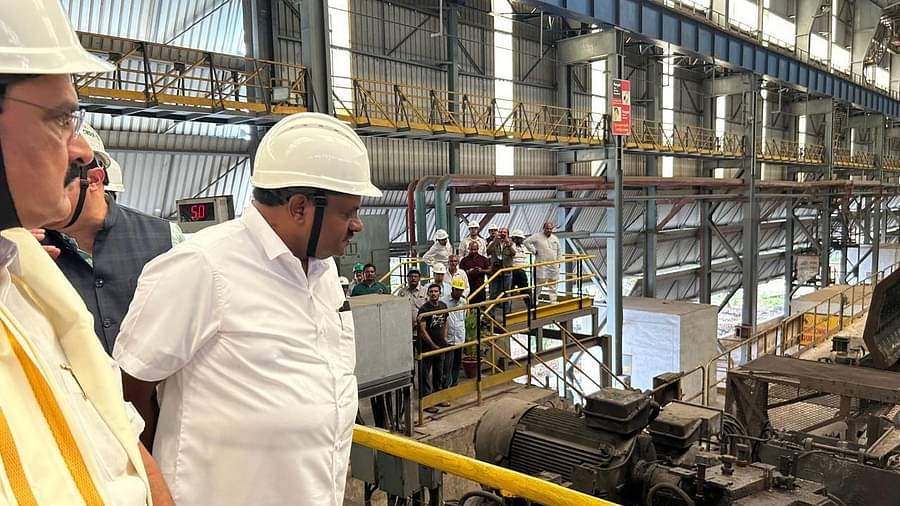
RINL Revival Talks: Kumaraswamy’s Push and PMO’s Role
Rashtriya Ispat Nigam Limited (RINL), the public-sector steel giant based in Visakhapatnam, has been a topic of intense discussions recently. The company’s financial struggles have led to widespread concern about its future, with stakeholders pushing for revival strategies. Former Karnataka Chief Minister H.D. Kumaraswamy’s engagement with the Prime Minister’s Office (PMO) has brought renewed focus to the issue. Let’s delve into the details of these critical discussions and what they mean for India’s steel sector.
The Current Status of RINL
Overview of RINL’s Financial Troubles
RINL, also known as Vizag Steel Plant, has faced mounting financial difficulties due to increasing operational costs, declining steel demand during economic downturns, and significant debt burdens. The company has been unable to generate sufficient revenue to cover expenses, prompting talks of privatization or revival.
Why RINL Matters to India
- Strategic Importance: RINL is a leading producer of long steel products in India and plays a pivotal role in infrastructure projects.
- Employment Generator: It employs thousands directly and indirectly, making it a lifeline for Visakhapatnam and nearby areas.
- Economic Impact: Reviving RINL could contribute significantly to India’s self-reliance in steel production and reduce dependence on imports.
Kumaraswamy’s Role in Revival Talks
The Background of Kumaraswamy’s Involvement
H.D. Kumaraswamy, known for his pro-development stance, has taken a keen interest in the revival of RINL. Leveraging his political influence, he has advocated for a sustainable solution to RINL’s crisis and engaged directly with the PMO.
Key Proposals by Kumaraswamy
- Debt Restructuring: Advocating for government-backed financial assistance and loan restructuring to ease RINL’s debt burden.
- Increased Investments: Suggesting partnerships with private players to inject capital without full privatization.
- Policy Reforms: Recommending tax reliefs and favorable policies to improve operational efficiency.
Impact of His Advocacy
Kumaraswamy’s discussions with the PMO aim to align stakeholders toward a unified strategy, ensuring that RINL remains a public-sector entity while regaining profitability.
PMO’s Role in the Revival Process
Government’s Vision for RINL
The PMO has underscored the importance of RINL in India’s economic framework and acknowledged the need for urgent intervention. The government is exploring several strategies, including partial divestment and restructuring.
Proposed Strategies Under Review
- Monetizing Non-Core Assets: Selling surplus land and other non-essential assets to generate revenue.
- Operational Overhauls: Implementing cost-cutting measures and introducing advanced technologies to increase efficiency.
- Global Collaborations: Partnering with international steel giants to enhance competitiveness.
Challenges to Revival
Resistance to Privatization
One of the major challenges in the revival process is the resistance from employees, unions, and local communities who fear job losses and reduced worker rights.
Market Volatility
Fluctuations in steel prices and raw material costs pose ongoing risks to RINL’s profitability, complicating long-term planning.
Policy Delays
Bureaucratic hurdles and delays in policy implementation could stall revival efforts, making it crucial for timely action by the government.
The Path Forward: Sustainable Solutions
Public-Private Partnership (PPP) Model
A well-structured PPP model could strike a balance between public control and private efficiency, ensuring RINL’s survival while protecting stakeholders’ interests.
Boosting Domestic Demand
Government initiatives to increase infrastructure spending and promote domestic steel consumption could provide a steady demand for RINL’s products.
Environmental Sustainability
Adopting green steel production techniques would not only align with global trends but also open doors to international markets prioritizing eco-friendly products.
The Ripple Effect of Revival
Economic Growth
A revived RINL could significantly boost India’s GDP by strengthening the manufacturing and infrastructure sectors.
Job Creation
Restoring RINL to profitability would safeguard existing jobs and create new employment opportunities, uplifting local communities.
Global Competitiveness
A strong RINL would position India as a global steel production leader, reducing dependency on imports and enhancing export capabilities.
Conclusion
The revival of RINL is not just about saving a company; it’s about preserving a vital asset for India’s economy. With the active involvement of leaders like H.D. Kumaraswamy and the PMO, there is hope for a robust and sustainable solution. However, the path forward requires collaboration, timely action, and a commitment to balancing profitability with public welfare.
FAQs
- What is the current status of RINL’s revival talks?
Discussions are ongoing, with significant input from political leaders like Kumaraswamy and the PMO to explore sustainable solutions. - Why is RINL important to India?
RINL is crucial for India’s infrastructure development, providing employment and reducing dependency on steel imports. - What challenges does RINL face?
Major challenges include financial debts, market volatility, and resistance to privatization. - What solutions are being proposed for RINL’s revival?
Solutions include debt restructuring, public-private partnerships, and operational reforms. - How will RINL’s revival benefit the Indian economy?
Reviving RINL could boost GDP, create jobs, and enhance India’s position in the global steel market.
